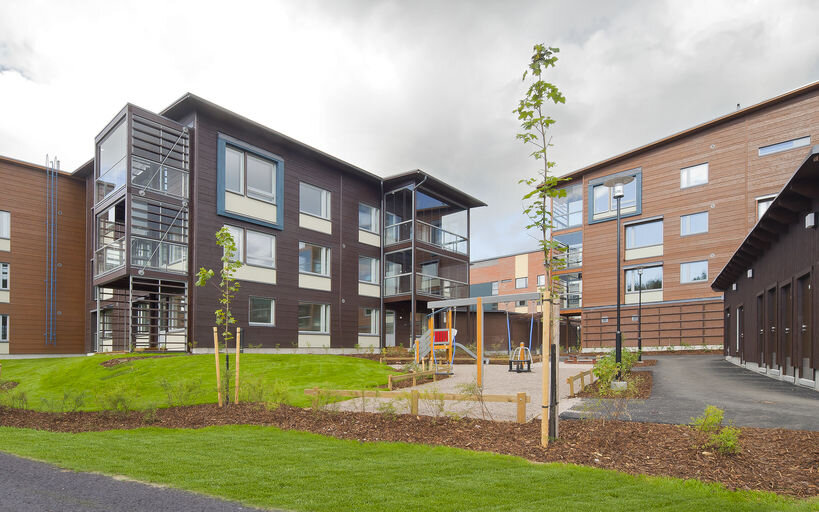#Multi-story buildings made of wood sell for 9% more than other construction in Helsinki

“#Multi-story buildings made of wood sell for 9% more than other construction in Helsinki”

Building more homes and buildings with wood has been on the radar for years as a way to offset carbon emissions, though construction companies have been hesitant to take the material in broader use. A study at Aalto University in Finland is now the first to show that building with wood can be a sound investment.
The team analyzed statistical data from real estate sales in the Finnish capital of Helsinki and two suburbs from 1999 to 2018. Of these, timber-built homes made up 2.23% of cases. The findings show that multi-storied buildings made out of wood sold for an average of 8.85% more than those made from other materials.
Previous research has pointed to perceptions of higher costs in wood construction, and until now there have been no definitive results on the material’s economic feasibility. Since many things can affect price, the researchers used regression analysis to control for other potential factors.
“At first glance multi-story housing blocks made out of wood appear to be cheaper on average but when we look more closely at the data and control for location, we see that it’s economically advantageous to use wood. The results show that wood-based housing is almost 10% more expensive per square meter than concrete-based housing in the same area,” explains Seppo Junnila, professor of real estate business at Aalto University.
Price differences between wood and other construction materials were not seen in the suburbs studied. The researchers say this may have to do with the fact that timber-based construction in Helsinki occurs in cheaper-than-average areas, where people may be more willing to pay for the eco-friendly material.
“These days many consumers value ecological choices, and at the same time, want to communicate their green preferences to others. Our results show that wooden buildings are located more often in areas with lower socio-economic status—wood is what boosts their prices,” explains Doctoral Student Ilmari Talvitie.
“Our previous research shows that if you buy a flat you’re more concerned about its environmental footprint than if you rent. An owner typically invests more in ways to improve performance, like energy-saving options. This principle seems to hold true here: Buyers are willing to pay more for an eco-friendly choice, even if they can’t afford to live in the most expensive neighborhoods of the city,” adds Junnila.
While Finland’s construction industry has been hesitant to invest in timber construction, the country’s government sees its potential: The Ministry of the Environment aims to have 45% of new multi-storied buildings constructed with wood by 2025.
“Just legislation isn’t enough to meet these goals. We need people to want to live in these kinds of buildings and construction firms need to see them as a business opportunity,” says Junnila.
Construction firms hesitate because of a lack of skills, resistance to change and a concern that wooden construction will be expensive, say the researchers.
“The cost of construction is just half of the cost of a home, so if the consumer is ready to pay nearly 10% for their wooden home, it’s an extremely worthwhile investment for the builder,” Junnila emphasizes.
Previous research has shown that boosting wood construction in cities is an effective way of storing carbon emissions. Deforestation, however, continues to be a hot topic worldwide.
“Wood construction is an excellent option in countries like Finland and other Nordic countries, where legislation requires that cut trees be replaced. It’s also worth remembering that, globally speaking, deforestation happens for other reasons—not wood construction. If we need a new building, wood is indisputably a good choice for our planet,” says Jussi Vimpari, a post-doctoral researcher at Aalto University.
Most importantly, in a world increasing fixated on carbon neutrality, a shift to wood construction can help cities around the planet meet their goals.
“Building with wood is essentially the only way for cities to store carbon—by definition they don’t have vast amounts of nature needed to sink carbon. The good news is that some international investment companies have already realized the potential of timber construction, and we can only expect this interest to grow,” says Junnila.
Building European cities with wood would sequester and store half of cement industry’s current carbon emissions
Ilmari Talvitie et al, Economic feasibility of wood-based structures – improving urban carbon neutrality strategies, Environmental Research: Infrastructure and Sustainability (2021). DOI: 10.1088/2634-4505/abfe05
Citation:
Multi-story buildings made of wood sell for 9% more than other construction in Helsinki (2021, May 20)
retrieved 20 May 2021
from https://phys.org/news/2021-05-multi-story-wood-helsinki.html
This document is subject to copyright. Apart from any fair dealing for the purpose of private study or research, no
part may be reproduced without the written permission. The content is provided for information purposes only.
If you liked the article, do not forget to share it with your friends. Follow us on Google News too, click on the star and choose us from your favorites.
For forums sites go to Forum.BuradaBiliyorum.Com
If you want to read more Like this articles, you can visit our Science category.



